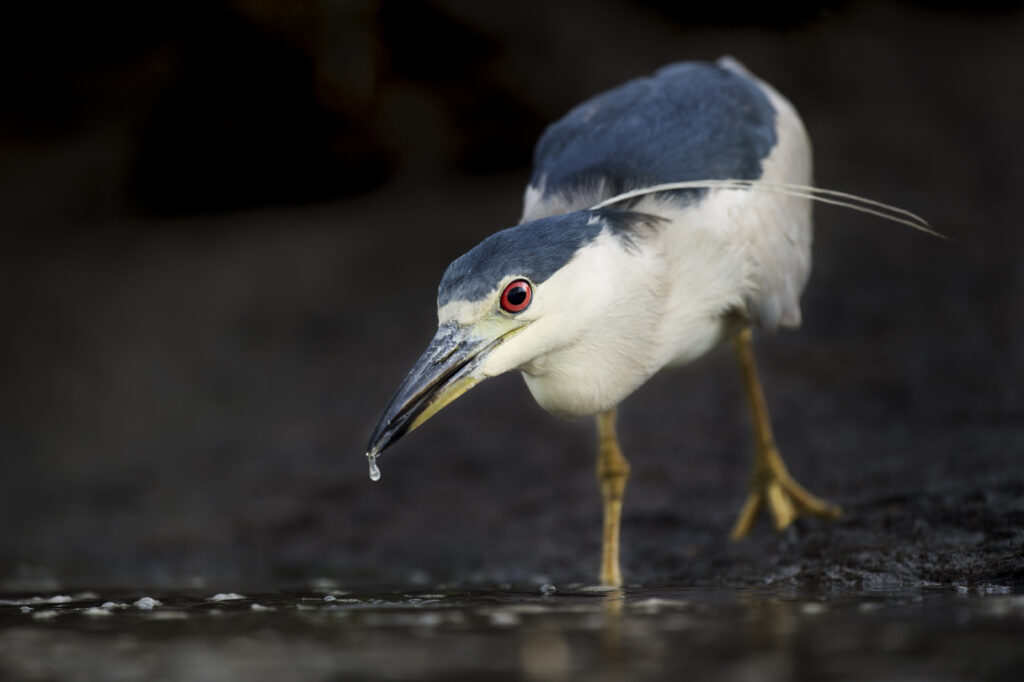The Black-Crowned Night Heron is the mysterious darker sibling to the elegant long-limber wading birds of the egret family. Unlike the ethereal Snowy Egret or the majestic Great Blue Heron, the Black-crowned Night Heron cuts a stocky silhouette against the waterways where it silently stalks the fish, reptiles, amphibians, and even mammals that cross its path. The Black-crowned Night Heron may lack that iconic elongated “S-curve” seen in the necks of its fellow of egrets, but these birds do not truly lack beauty.
The Black-crowned Night Heron is striking with dove gray feathers, a black crown that extends down the back, and alert red eyes that scan the water for potential meals. Black-crowned Night Herons are found in the Americas, Africa, and much of Asia. These birds embody the richness of the wetland habitats that they call home.
Related Article: Species Spotlight: The Greater Rhea
Fun Facts About the Black-crowned Night Heron
The Black-crowned Night Heron might be the proverbial “black sheep” of the egret family, but in a family so chock-full of breath-taking birds, even the oddballs are exceptional in their own way. Let’s look at some Black-crowned Night Heron fun facts to learn just what makes these birds so special.
Friends of a feather: Black-crowned Night Herons are mysterious looking, but don’t let that hunched posture and black cap fool you — these birds are the life of the party! Black-crowned Night Herons are loud and gregarious birds that tend to roost in enormous colonies. They’re so sociable, as a matter of fact, that these colonies may include other types of birds. They have been known to nest in close quarters to other types of herons and egrets as well as ibises.
Building a relationship: Black-crowned Night Heron romance is old school. The male begins by establishing a nesting spot and displaying to the female. Once she chooses him, the male begins to bring her gifts in the form of sticks and other nesting materials. Once he has proven that he can provide, the female gets to work using the nesting materials to build the nest that the pair will use.
Puke for protection: Young Black-crowned Night Herons are pretty defenseless. They are completely unable to regulate their own body temperature once hatched and require constant care from their parents until they grow bigger. It takes four weeks for chicks to be able to leave the nest at all, and several more weeks before they obtain actual independence. Because they’re so helpless, Black-crowned Night Heron chicks have developed an unsavory defense mechanism to drive away threats. When approached, they regurgitate their last meal onto the intruder. The smell and general unpleasantness of being puked on by an awkward gangly baby heron tends to deter predators.
Motherly instincts: Mothering comes naturally to female Black-crowned Night Herons. They’re so motherly that they’ll even brood another birds’ chicks. In fact, when she’s in breeding mode, a mother Black-crowned Night Heron will brood any chick that’s placed in her nest as if it were her own. It is believed that these birds can’t distinguish between their offspring and that of another heron. Though it might have some drawbacks, this quirk makes the Black-crowned Night Heron the ultimate babysitter.
The Future of the Black-crowned Night Heron
The Black-crowned Night Heron is listed as “Least Concern” by the International Union for the Conservation of Nature’s “Red List of Threatened Species.” The list does note that the Black-crowned Night Heron is globally decreasing, however their populations are stable enough worldwide to avoid being designated as “Near Threatened.” In some sections of their range, such as Pennsylvania, the Black-crowned Night Heron is endangered and has all but disappeared from waterways where they were once abundant. The presence or absence of healthy wading bird populations is a strong indicator of the health of a region’s wetlands.
Popular Article: Species Spotlight: The Hermit Thrush

